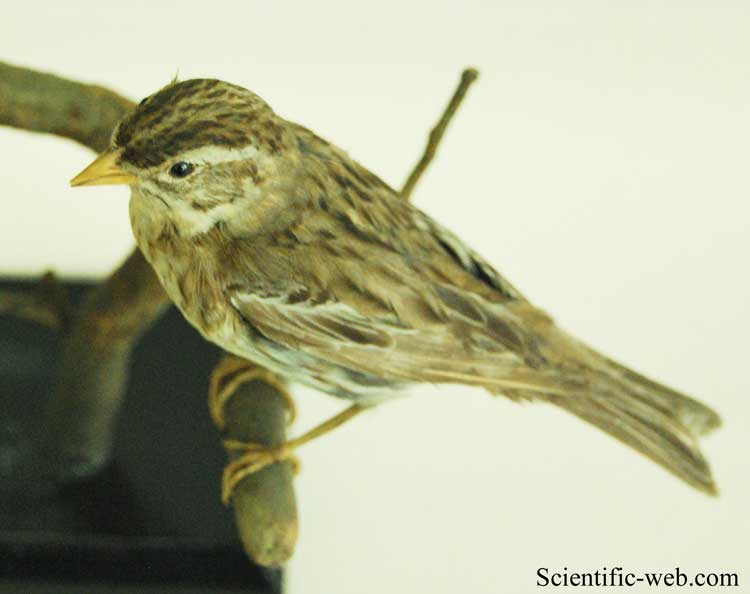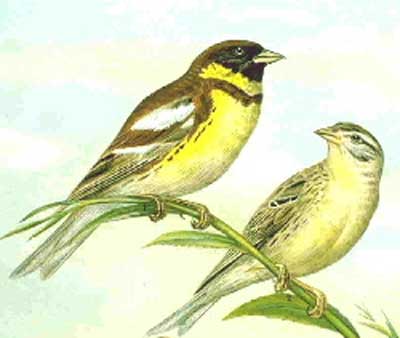
Emberiza aureola , Photo: Michael Lahanas
Superregnum: Eukaryota
Cladus: Unikonta
Cladus: Opisthokonta
Cladus: Holozoa
Regnum: Animalia
Subregnum: Eumetazoa
Cladus: Bilateria
Cladus: Nephrozoa
Superphylum: Deuterostomia
Phylum: Chordata
Subphylum: Vertebrata
Infraphylum: Gnathostomata
Megaclassis: Osteichthyes
Cladus: Sarcopterygii
Cladus: Rhipidistia
Cladus: Tetrapodomorpha
Cladus: Eotetrapodiformes
Cladus: Elpistostegalia
Superclassis: Tetrapoda
Cladus: Reptiliomorpha
Cladus: Amniota
Classis: Reptilia
Cladus: Eureptilia
Cladus: Romeriida
Subclassis: Diapsida
Cladus: Sauria
Infraclassis: Archosauromorpha
Cladus: Crurotarsi
Divisio: Archosauria
Cladus: Avemetatarsalia
Cladus: Ornithodira
Subtaxon: Dinosauromorpha
Cladus: Dinosauriformes
Cladus: Dracohors
Cladus: Dinosauria
Ordo: Saurischia
Cladus: Eusaurischia
Subordo: Theropoda
Cladus: Neotheropoda
Cladus: Averostra
Cladus: Tetanurae
Cladus: Avetheropoda
Cladus: Coelurosauria
Cladus: Tyrannoraptora
Cladus: Maniraptoromorpha
Cladus: Maniraptoriformes
Cladus: Maniraptora
Cladus: Pennaraptora
Cladus: Paraves
Cladus: Eumaniraptora
Cladus: Avialae
Infraclassis: Aves
Cladus: Euavialae
Cladus: Avebrevicauda
Cladus: Pygostylia
Cladus: Ornithothoraces
Cladus: Ornithuromorpha
Cladus: Carinatae
Parvclassis: Neornithes
Cohors: Neognathae
Cladus: Neoaves
Cladus: Telluraves
Cladus: Australaves
Ordo: Passeriformes
Subordo: Passeri
Infraordo: Passerida
Superfamilia: Passeroidea
Familia: Emberizidae
Genus: Emberiza
Species: Emberiza aureola
Subspecies: E. a. aureola – E. a. ornata
Name
Emberiza aureola Pallas, 1773
Synonyms
Emberiza luteola Sparrman, 1789 [=Sicalis luteola (Sparrman, 1789)]

Emberiza aureola
References
Primary references
Pallas, P.S. 1773. Reise durch verschiedene Provinzen des russischen Reichs. Zweyter Theil. Zweytes Buch vom Jahr 1771. St. Petersburg: Kayserlichen Academie der Wissenschaften. Pp. 371–744 + pls 9–10, 12–14 + A–H, J–T, T*, U, W–Z. (Online). Reference page. [see page 711.]
Links
IUCN: Emberiza aureola (Critically Endangered)
Vernacular names
brezhoneg: Brean-haleg
català: Sit caranegre
čeština: Strnad obojkový
Deutsch: Weidenammer
English: Yellow-breasted Bunting
Esperanto: Brunrubanda emberizo
español: Escribano aureolado
eesti: Kuldtsiitsitaja
euskara: Berdantza papohori
suomi: Kultasirkku
føroyskt: Bringugulur spurvur
français: Bruant auréole
galego: Escribenta aureolada
magyar: Aranyos sármány
日本語: シマアオジ
монгол: Шарэлэгт хөмрөг
Bahasa Melayu: Burung Pipit Dada Kuning
Nederlands: Wilgengors
norsk: Sibirspurv
polski: Trznadel złotawy
português: Escrevedeira-aureolada
русский: Дубровник
саха тыла: Талах чыычааҕа
svenska: Gyllensparv
Türkçe: Kuşaklı kiraz kuşu
中文(繁體): 金鵐
中文: 黄胸鹀
The yellow-breasted bunting (Emberiza aureola) is a passerine bird in the bunting family Emberizidae that is found across the Boreal and East Palearctic. The genus name Emberiza is from Old German Embritz, a bunting. The specific aureola is Latin for "golden".[2] The bird's call is a distinctive zick, and the song is a clear tru-tru, tri-tri.
Until 2004, the International Union for Conservation of Nature considered the yellow-breasted bunting to be a species of least concern. Since 2004, it has been gradually upgraded to a status of Critically Endangered due to rapid drops in population sizes.[1] It is subject to heavy hunting pressure in China, through which most specimens pass during migration.[3]
Description
The yellow-breasted bunting is a small passerine, ranging from 14 to 16 cm (5.5 to 6.3 in) in length, and weighing 17 to 26 g (0.6 to 0.9 oz). For a bunting, it is large and rather stocky.[4]
The breeding male has bright yellow underparts with black flank streaks, brown upperparts, black face and throat bar, and a pink lower mandible. The female has a heavily streaked grey-brown back, and less intensely yellow underparts. She has a whitish face with dark crown, eye and cheek stripes. The juvenile is similar, but the background colour of the underparts and face is buff.
Distribution and habitat
Schoeniclus aureolus aureolus breeds in boreal forests of Finland to Bering Sea migrating to Indochina Schoeniclus aureolus ornatus breeds from the Amur River to Manchuria, N Korea, Kamchatka and Kuril Islands. It is migratory, wintering in south-east Asia, India, and southern China. It is a rare but regular wanderer to western Europe. There are also ~4 records from the Aleutian Islands of Alaska and a 2017 record from Labrador, Canada. The species winters in large flocks in cultivated areas, rice fields and grasslands, preferring to roost in rice-fields.[1]
Breeding
The yellow-breasted bunting breeds in open scrubby areas that consist of dry water rice fields for foraging and reedbeds for roosting, often near water, and is present in Siberia. It lays four to six eggs in a nest on the ground. Its food consists of insects when feeding young, and otherwise seeds.
Conservation
Populations have declined precipitously since the early 2000s, and the species is now considered to be critically endangered. The decline of the yellow-breasted bunting is likely to be caused by substantial trapping during migration and most specifically at winter sites. Birds are flushed then caught in mist-nets, to be sold for consumption as "sparrows" or "rice birds". Even though the actions have been restricted to a small area in southern China, it has become more widespread and popular to increasing wealth, and hunters now travel long distances to find sufficient birds. Shifts in rice paddy irrigation practices have reduced the quality and quantity of wintering habitats, including the loss of water stubble, and the loss of reedbeds has reduced available roost sites.[1]
References
BirdLife International (2017). "Emberiza aureola". IUCN Red List of Threatened Species. 2017: e.T22720966A119335690. doi:10.2305/IUCN.UK.2017-3.RLTS.T22720966A119335690.en. Retrieved 19 November 2021.
Jobling, James A. (2010). The Helm Dictionary of Scientific Bird Names. London, United Kingdom: Christopher Helm. pp. 62, 145. ISBN 978-1-4081-2501-4.
"abundant bird species could be wiped out like passenger pigeons". Retrieved 9 June 2015.
Brazil, Mark (2009). Birds of East Asia. London, UK: Christopher Helm. p. 488. ISBN 978-0-7136-7040-0.
Retrieved from "http://en.wikipedia.org/"
All text is available under the terms of the GNU Free Documentation License

